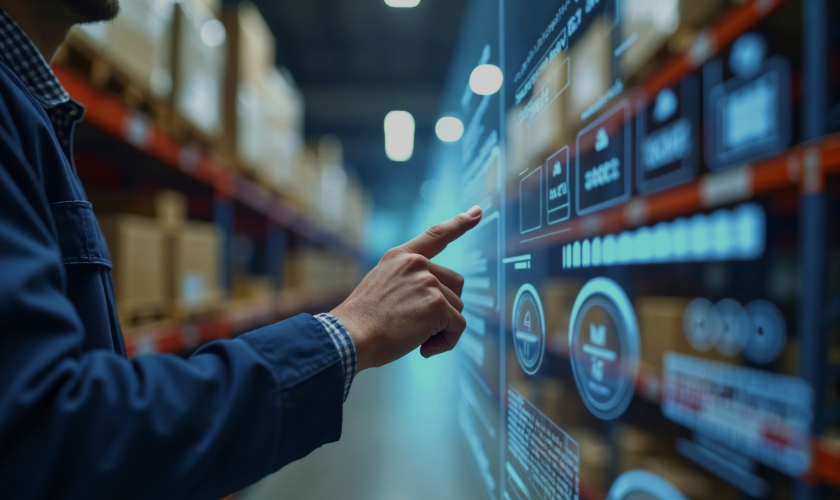Top 14 Examples of Headless Commerce from Industry Leaders

Imagine this: you’re managing the ecommerce platform for a global brand, but every site update is like trying to do surgery with a butter knife. It takes months to deploy a new feature, omnichannel consistency is a pipe dream, and scaling feels like pushing a boulder uphill. Most companies hit these hurdles before embracing headless commerce.
What is headless commerce, you might wonder? As explained in detail in our guide, this architecture is a chance for brands to escape monolithic all-in-one platforms and become more agile. In this article, we’ll explore real headless ecommerce examples — including those from Expert Soft’s experience — of companies leveraging headless commerce to stay flexible, improve customer experiences, and develop future-proof digital strategies.
Quick Tips for Busy People
Check out these headless commerce examples and how brands achieved real results with headless architecture.
- Scalable growth worldwide. Ruggableand and Taschen expanded globally with multilingual sites, smoother workflows, and reduced operational costs.
- Customization and branded experiences. ALDO Group, Nour Hammour, Tommy Hilfiger, TradeTools, and Burrow created personalized shopping experiences, pushed faster updates, and boosted conversion rates.
- Content management optimization. Burberry and K2 Sports simplified content management using headless CMS platforms, accelerating updates and minimizing developer dependency.
- Omnichannel integration. Sephora, Pentair, and Coca-Cola HBC delivered seamless online and offline experiences with real-time inventory updates and faster transactions.
Before starting to explore how these examples of headless technology work in real life, let’s quickly review the value headless commerce can bring to global corporations.
The Value of Headless for Brands
Why are top brands across the globe switching from monolithic to headless platforms? Because of quite a few advantages of headless commerce for businesses. Here’s what’s fueling the change:
- Flexibility & agility. A decoupled front-end provides the freedom to make quick UI/UX changes without impacting back-end processes.
- Seamless omnichannel presence. Headless architecture guarantees a smooth experience on mobile, desktop, in-store kiosks, and IoT devices.
- Faster innovation. A headless setup supports fast integration of new technologies and global scaling with minimal downtime.
- Better performance. A headless solution enhances page speed and page load times for better user experience and SEO optimization.
- Better scalability. A headless platform supports growing businesses by scaling well to handle high volumes of traffic and more products.
Do these advantages really impact brands or is it just another “appealing in words — headache in reality” approach? The headless commerce examples below will help you decide.
Headless Commerce Success Stories
Rather than listing examples in a random order that might confuse rather than help, we’ve categorized them based on the key goals global ecommerce enterprises and mid-size companies aimed to achieve with headless commerce implementation.
Scalable solutions for global expansion
As companies go global, businesses often hit roadblocks: legacy systems, slow performance, and the inability to manage multiple markets efficiently. But with headless architecture, brands can shatter these bottlenecks. This is how headless ecommerce examples enabled global brands to scale quickly, optimize operations, and enhance performance in international markets.
A top 250 global cosmetics brand
Challenge. A leading luxury cosmetics brand struggled with expensive operations, slow performance, and the challenge of running eight independent shops in European markets on an outdated platform.
Solution. Expert Soft implemented a headless architecture using SAP Commerce Cloud and Spartacus — a reliable mix offered by SAP. With the decoupled back-end that communicates with independent front-ends through the optimized APIs, each website benefited from quicker, independent operations without platform bottlenecks. Enhanced cache management cut loading times, and team synchronization tools allowed for more effective cross-market coordination and quicker content updates.
A renowned art book publisher
Challenge. Taschen, a well-known art publisher, wished to expand its online presence but was finding its existing platform too sluggish and inflexible. New features were cumbersome to add and updates were taking too much time. To venture into new markets worldwide and provide an improved online experience, they required a more agile and stable solution.
Solution. Taschen created a headless ecommerce website with integrated product management and seamless checkout. The headless approach made it easy to add features, connect with third-party suppliers, and manage online and in-store sales together. Within five months, Taschen deployed its new website in several languages, increasing sales by 20%.
A home decor brand
Challenge. Ruggable, a producer of washable rugs, required a flexible ecommerce platform to facilitate international growth at scale, streamline site performance, and provide a unified shopping experience across markets and channels.
Solution. Ruggable embraced headless architecture and composable website structure, providing them with the flexibility to scale fast and control various markets through a single platform. This enabled the brand to deploy to eight global markets within a month, with translations in-region and regional storefronts. With a more stable and faster site and optimized SEO, the company enhanced search engine visibility and performance.
Omnichannel integration
Blending online and offline experiences is not merely a matter of convenience for modern customers. This is a crucial step in providing users with flexibility and consistency, no matter how they shop. The headless approach enables brands to merge sales channels, personalize customer experiences, and offer services such as BOPIS and real-time order tracking without interfering with back-end processes. Let’s look at some headless website examples and how these companies leveraged headless solutions to develop seamless omnichannel experiences.
A global beauty retailer
Challenge. When omnichannel fulfillment became a key trend in retail, Sephora was among the first companies that introduced it, implementing buy online pickup in store (BOPIS) and same-day delivery capabilities. To expand these features even more, the company looked for a more flexible and efficient system, as its legacy platform lacked the agility to support the seamless integration of in-store and online operations.
With growing customer expectations for speed, convenience, and personalization, Sephora needed a solution that would streamline order fulfillment across channels without disrupting operations.
Solution. Sephora embarked on a headless commerce architecture by migrating to Commercetools, a cloud-native solution that separates the front-end customer experience from the back-end system. That enabled Sephora to consolidate in-store and online operations, facilitating speedier transactions, faster BOPIS services, and same-day deliveries throughout the U.S. and Canada.
The new system also supports personalized shopping experiences by providing customized product recommendations and personalized checkout experiences based on customers’ activity, without hindering back-end operations.
A leading beverage company
Challenge. Operating on a B2B ecommerce model, Coca-Cola Hellenic Bottling Company (Coca-Cola HBC) wanted to shift the core order volume from the call centers to online channels, ensuring a smooth and consistent omnichannel experience. The company’s previous ecommerce infrastructure was too inflexible to update regularly and didn’t scale quickly enough to capture growing demand from business customers.
Solution. Coca-Cola HBC embraced headless architecture using SAP Commerce Cloud and a composable storefront, separating the front- and back-ends to roll out features quicker and more tailored customer experiences. The configuration enabled their team to create and manage particular components separately, enhancing site performance and allowing the brand to react faster to customers’ requirements.
With the headless setup, Coca-Cola HBC realized faster updates, improved scalability, and a smoother customer experience, serving 160,000 business customers and processing over 130,000 orders monthly.
A water solution leader
Challenge. Pentair, a global provider of smart water solutions, needed to unify B2B, B2C, and contractor experiences into a single, seamless digital platform. With multiple ERPs, warehouses, and brands, their legacy system lacked the flexibility to support direct-to-consumer (DTC) sales without disrupting existing B2B relationships.
Solution. Pentair turned to a headless hybrid approach, using Adobe Experience Manager for content management, Adobe Commerce for transactions, and a data integration platform to unify order processing and pricing across multiple back-end systems.
With all these, Pentair was able to streamline its customer journey, ensuring flexibility, scalability, and seamless omnichannel engagement. By consolidating its digital touchpoints, the company enhanced personalization and customer experience without disrupting its existing B2B operations.
Content management enhancements
Managing content across multiple platforms, and languages can quickly become a bottleneck, particularly if every change has to pass through a developer. However, with headless CMS, brands are accelerating content updates, streamlining workflows, and freeing their teams. Let us look at three headless technology examples of companies that transformed their content management for quicker operations.
A global financial data provider
Challenge. A cumbersome content management process, established in a global financial data provider, hindered their system agility in content updates. Because of business specifics, there was a need for frequent content changes, but each modification relied on developers, creating bottlenecks. The company needed a more flexible and scalable solution that would allow business users to manage content directly.
Solution. To streamline content management, Expert Soft implemented Contentful as a headless CMS, ensuring seamless integration with the company’s React-based front end. The CMS relied on modular content components, such as banners, images, links, and other reusable blocks, which still required the developers’ assistance for the initial setup. However, after the setup was completed, non-technical users were granted the ability to update content effortlessly. By eliminating the need for developer involvement in routine content updates, the company accelerated content workflows, improved efficiency, and enhanced website scalability.
A luxury fashion brand
Challenge. Burberry was being constrained by a legacy ecommerce platform that was making it difficult to handle multiple collections, translations, and rapidly changing campaigns. New collections were taking too long to get to customers, and the online experience was falling short of Burberry’s creative and innovative spirit.
Solution. To gain more flexibility, Burberry adopted a MACH approach, using the Contentstack CMS as the headless component. This enabled quicker content updates, real-time previews, and simpler management in 11 languages. With the MACH setup, Burberry cut developer tickets from 40 to 1 weekly and enhanced global content publishing speed and agility.
A global leader in outdoor recreational products
Challenge. K2 Sports, home to several iconic outdoor brands, struggled with its previous platform. The mix of limited ability to create engaging shopping experiences and the platform’s high costs and time-consuming maintenance made it an inefficient option for the company. Managing multiple brand sites became expensive and complex, especially as they aimed to expand internationally.
Solution. K2 Sports moved to a headless architecture with BigCommerce as the back-end and Contentstack as the headless CMS for serving content-rich experiences on its brand websites. Through this headless configuration, K2 could handle content in the best possible manner and give each brand its own voice without compromising on its high levels of innovation and customer delight.
The new environment allowed for more rapid content creation, with sites created 75% faster, content released 90% quicker, and overall productivity increased by 50%.
Supporting unique brand experiences and customization
For those creativity- and personalization-driven brands, a monolithic ecommerce solution usually can’t provide the required flexibility level. For this, more agile systems are needed and the headless approach can deliver this. Here are several headless website examples of how brands leveraged this setup to create adaptable, speedy, and unforgettable online experiences.
A global fashion retailer
Challenge. ALDO Group, the parent company of brands like ALDO, Call It Spring, and GLOBO, aimed to deliver a unified shopping experience across online and offline channels. Its existing ecommerce platform couldn’t keep pace with rapidly evolving consumer expectations and lacked the flexibility to personalize experiences, minimize returns, and tie inventory across channels.
Solution. Leveraging the composable approach of SAP solutions, ALDO Group implemented a headless architecture with SAP Commerce Cloud, SAP Emarsys Customer Engagement, and SAP Customer Activity Repository. The modularity enabled ALDO to provide personalized recommendations, real-time inventory checking, and an easier checkout experience. The headless architecture also simplified scaling, incorporating new technologies, and adapting to evolving customer expectations across channels more quickly.
A luxury outerwear brand
Challenge. Nour Hammour wished to take its custom showroom experience online. As luxury is an emotional experience, the brand wanted to ensure the same engagement level within the online touchpoints.
So, the brand required an ecommerce website with the authority to express the brand’s vision while being quick, mobile-first, and video-friendly. Their current website seemed sluggish on mobile, in particular, and didn’t fit the high-end, immersive experience they wished for their clientele.
Solution. Nour Hammour embraced a headless architecture to create a responsive, high-performance ecommerce experience. With a decoupled front-end developed using Shopify’s Hydrogen toolkit, the brand realized quicker load times, better SEO, and a smooth shopping experience. The headless configuration made it simple to integrate with Sanity CMS for better content management and MUX Video for high-definition, quick-loading videos.
This modular, headless strategy provided Nour Hammour with the flexibility to make content changes swiftly, scale worldwide, and provide a luxury digital experience, leading to a 63% rise in conversion rates.
A luxury furniture brand
Challenge. Burrow outgrew their ecommerce solution following early success. They required a scalable back-end to facilitate growth and a flexible front-end for speedy content updates and innovative marketing with zero reliance on developers.
Solution. Burrow implemented BigCommerce for its secure back-end and low maintenance, freeing up the team for marketing updates. A custom CMS allowed for creative control, avoiding template limitations and structuring their modular product line easily. This led to a 30% conversion rate increase and a 50% faster site speed within two months.
A global fashion brand
Challenge. Tommy Hilfiger collaborated with Patta to launch a collection inspired by 90s hip-hop culture. They required an ecommerce solution that would support high-bandwidth content such as animations, HD video, and images without lagging or freezing under high traffic, particularly on the launch date.
Solution. Tommy chose a headless architecture for a fast build and a snappy, high-speed shopping journey. The decoupled front- and back-ends meant the team could construct and launch the entire store much more quickly than if they did so using a monolithic setup. The modularity of the headless approach allowed for customizing the layout, navigation, and checkout process, guaranteeing seamless performance amid high-traffic events.
A tool retailer
Challenge. TradeTools, an Australian tool retailer catering to both B2B and B2C customers, needed a future-proof, flexible ecommerce platform. Their existing headless setup on Magento allowed for customization, but became increasingly difficult to scale and manage. They required a robust headless solution that could maintain front-end independence while offering greater agility and performance.
Solution. TradeTools migrated to BigCommerce’s headless architecture, seamlessly switching back-end platforms while preserving their front-end experience. The transition enabled faster feature rollouts, improved checkout flows, and streamlined integrations with third-party tools like ShipperHQ for shipping automation and Signifyd for fraud prevention.
To Sum Up
Headless commerce examples above illustrate how the headless approach empowers businesses to overcome digital challenges. While having different reasons in mind for the headless implementation, each company ended up with approximately the same: faster websites, smoother customer experiences, and personalized interactions. Beyond these technical gains, the value of headless also shined brightly in what they enable: stronger customer loyalty, increased conversions, and the ability to quickly adapt to market changes. With a headless setup, companies aren’t just solving current problems, they’re building a future-ready foundation for continuous growth and innovation.
Probably, headless commerce is the next step for your business as well. If so, Expert Soft can help you explore available options, provide guidance, or support your migration to a headless setup. Let’s talk!

Kate Savastsiuk, Head of Digital Transformation and Customer Experience at Expert Soft, helps businesses navigate headless commerce adoption. Her experience working with industry leaders provides valuable insights into successful headless implementations and their impact on digital growth.
New articles

See more

See more

See more

See more

See more
